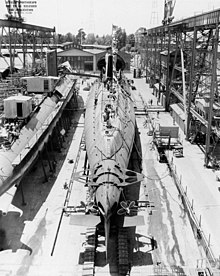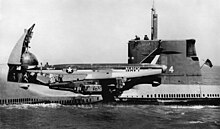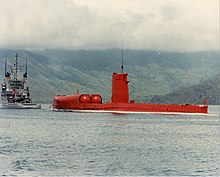USS Grayback (SSG-574)
 Grayback (LPSS-574), underway, c. 1968
| |
| History | |
|---|---|
| Name | USS Grayback |
| Ordered | 10 March 1951 |
| Builder | Mare Island Naval Shipyard |
| Laid down | 1 July 1954 |
| Launched | 2 July 1957 |
| Sponsored by | Mrs. John A. Moore |
| Commissioned | 7 March 1958, as SSG-574 |
| Decommissioned | 25 May 1964 |
| Recommissioned | 9 May 1969, as LPSS-574 |
| Decommissioned | 15 January 1984 |
| Stricken | 16 January 1984 |
| Homeport | Pearl Harbor |
| Motto | De Profundis Futurus |
| Fate | Sunk as a target near Subic Bay, 13 April 1986 |
| General characteristics | |
| Class and type | Grayback-class submarine |
| Displacement |
|
| Length | 273 ft (83 m) later extended to 317 ft 7 in (96.80 m) |
| Beam | 27 ft 2 in (8.28 m) |
| Draft | 19 ft (5.8 m) |
| Propulsion | 3 Diesel engines, 2 Elliott electric motors |
| Speed | |
| Complement | 84 officers and men |
| Armament |
|
USS Grayback (SS/SSG/APSS/LPSS-574), the lead ship of her class of submarine, was the second ship of the United States Navy to be named for the grayback.
Construction and commissioning
Grayback′s
Operational history
Guided missile submarine


Grayback represented a new class of SSG guided missile submarines, and was to be the first to carry the
On 9 February 1959, Grayback departed Mare Island to make Pearl Harbor her permanent home base, reaching Hawaii on 7 March via
On 22 February 1960, Grayback modified her missile launching system and simplified her complex electrical circuits. After this, she again took up deterrent missile strike missions. Over the next 2½ years she completed seven missions for a total of nearly 18 months at sea, much of this time submerged. In addition to Yokosuka, both Adak, Alaska, and Pearl Harbor also served as termination points for these patrols. On her nine patrols she spent more than 20 months at sea and logged over 130,000 miles (209,000 km) on deterrent missile strike missions.
That schedule took its toll. On 27 August 1963, while snorkeling to recharge batteries, Grayback was buffeted by particularly strong seas. The buffeting caused the After Main Battery breaker to short, starting a fire in the berthing compartment. One seaman failed to evacuate the compartment and was overcome by smoke and fumes. Main propulsion was lost for a short time, was restored, and Grayback returned to Pearl Harbor under her own power. Repairs took two weeks.
According to the documentary "Regulus: The First Nuclear Missile Submarines" the primary target for Grayback in the event of a nuclear exchange would be to eliminate the Soviet naval base at Petropavlovsk-Kamchatsky.[2] The patrols made by Grayback and its sister Regulus-firing submarines represented the first ever deterrent patrols in the history of the submarine Navy, preceding those made by the Polaris missile firing submarines.[2]
As more Polaris missile submarines became operational, they assumed the deterrent functions previously assigned to Grayback and her sister ships. The Regulus missile program ended in 1964 and Grayback was withdrawn from active service. She decommissioned at Mare Island Naval Shipyard, California, on 25 May 1964.
Amphibious transport submarine

A second conversion began at the

The conversion heightened her sail by ten feet, added two auxiliary tanks to the forward end of the engine room (increasing the length of the boat by 12 feet), and converted the missile chambers to carry 67 embarked troops and SEAL
In June 1972, the Grayback carried a team of
In January 1982 five U.S. Navy divers died when a vacuum was inadvertently drawn in a chamber on Grayback off the coast of Subic Bay. The diving accident led to changes in how the Navy designed, built, maintained and operated complex submarine based diving systems.[3]
Grayback was decommissioned for the second time on 15 January 1984 at
Awards
| National Defense Service Medal | Vietnam Service Medal | Republic of Vietnam Campaign Medal |
In April 1997, officers and men of Grayback and the other four US Navy submarines that conducted strategic deterrent patrols in the Western Pacific between 1959 and 1964 were awarded the right to wear the Navy's SSBN Deterrent Patrol insignia.
References
- ^ "Vought SSM-N-9/RGM-15 Regulus II." Parsch, Andreas, Directory of U.S. Military Rockets and Missiles, 2001. Retrieved: 6 January 2013.
- ^ a b Regulus: The First Nuclear Missile Submarines documentary, Spark, 2002
- ^ Davies, Sydney (2020-01-16). "January 16, 2020 - Commemorating the 38-Year Anniversary of the USS Grayback Accident". EB Landing. Retrieved 2024-01-24.
- ^ "Patrol Insignia for Regulus veterans" (PDF). Navy Nuclear Weapons Association. Summer 1997. Retrieved 12 November 2014.
This article incorporates text from the public domain Dictionary of American Naval Fighting Ships. The entry can be found here. Gardiner, Robert. "Conway's All the World's Fighting Ships 1947-1995." London: Conway Maritime Press, Ltd, 1995 Pg. 609-610
External links
- navsource.org: USS Grayback
- USS Grayback tribute webpage
- USS Grayback technical information, pictures schematics


